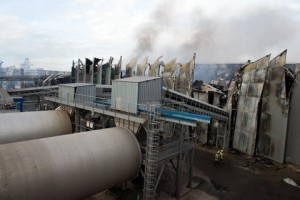A fire broke out at around 2:30○a.m. in a 2000○m² sorting building at a waste processing facility. The facility, which was commissioned in 2010, sits on an isolated 18○hectare plot in an industrial port area. Driven by the wind, the flames spread in a matter of minutes to an 8000○m² compost storage and ripening area (4000○tonnes of compost). Incandescent cinders, drawn into the fans used to keep the buildings at negative pressure, caused the fire to spread to the air handler and deodoriser (biofilters along 3000○m²). In less than one○hour, the fire spread to a 5000○m² sorting area containing plastics.
The flames then progressed to the conveyor belts, which ran through firewalls, and to the glulam frames surrounding them. At around 6:30○a.m., pieces of the burning frame fell into two pits filled with municipal waste (surface area: 27,000○m³; depth: 20○m), igniting the waste. A total of 140 firefighters and 40 vehicles were called to the scene. The extent of the facilities to be saved (biogas digesters, incinerator), the debris from partially collapsed structures, the weather conditions and the thick, persistent smoke made fighting the blaze particularly difficult. The extinguishing water was contained on the site and reused in a closed circuit. The fire was contained that evening. The fire in the pits, in the biofilter, and on the roof of the site’s train station was extinguished during the evening of 4○November. The site was monitored for flare-ups until 8○November. Despite the thick smoke that billowed mainly toward the industrial area, there were no immediate risks to people.
An emergency management body was contacted. Air, water, soil, and plant samples were collected to determine the fire’s environmental impacts (parameters analysed: COD, PAHs, phthalates, PCBs, dioxins and furans, metals). The marine environment was also monitored. The analyses showed that the fire had no significant environmental impacts.
The primary and secondary sorting facilities, the biofilter, and the three buildings housing them (18,000○m² total) were destroyed. Two digesters and the incinerator were saved. An incineration line (primary air supply box of a furnace) was damaged at around 6:00○a.m. by a carbon-monoxide explosion that occurred after the furnace was shut down three hours earlier. The fire caused several tens of millions of euros in property damage and business interruption. A portion of the waste usually processed by the facility was sent to other facilities. The facility operated at 85% capacity for 18 to 24○months. The media reported that the loss assessors agreed that the fire was caused by a malicious act.
The analysis of the speed at which the fire spread revealed multiple flaws in the design of the facilities (for aesthetic reasons, perhaps?):
- The firewalls did not extend into the roof space and only some of the pass-through conveyors had water curtains.
- There were many flammable components (exterior elements, wooden frames, PVC, etc.).
- Smoke extraction and partitioning was insufficient.
- Although 200 smoke detectors or flame detectors were fitted throughout the buildings and electrical-equipment rooms, none were located in the area where the fire started. By the time the alarm had been sounded by a detector in an electrical-equipment room on the building’s first floor, the fire had already grown.
- There was a sufficient number of fire-water ponds, but they had been poorly designed during rebuilding.
- The fire suppression resources will be strengthened: an onsite fire brigade (equipped with SCBAs) will be created, a 2000○l/min monitor with two 1000○l emulsifier tanks will be added, fire hydrants will be placed in the storerooms, and the number of water monitors around the waste pit and smoke extraction domes will be doubled.
The internal emergency plan was updated with the firefighters and the control room was sheltered from smoke. The site also improved the intrusion prevention systems.
Download the detailed report in .pdf format (937 Kb)




